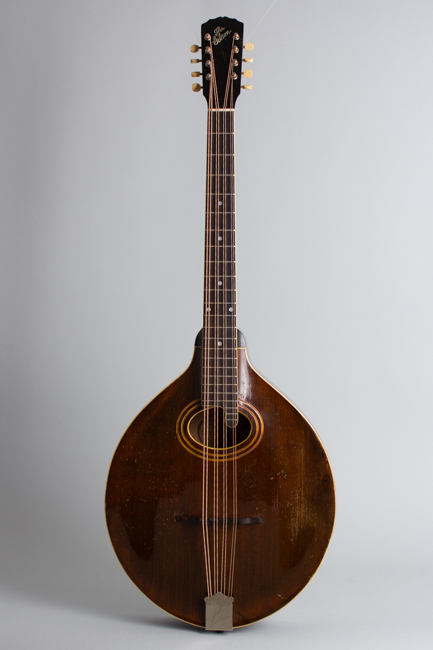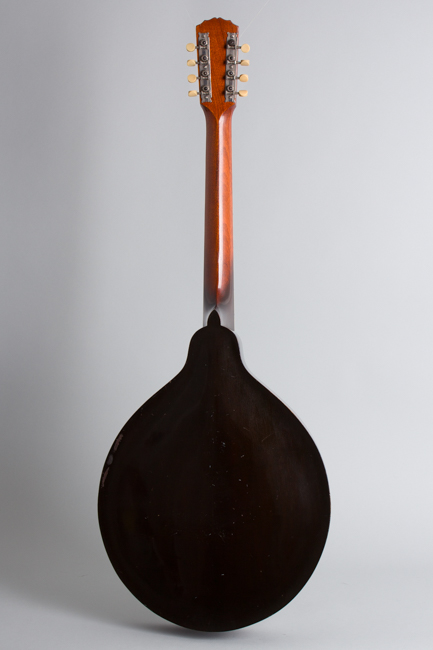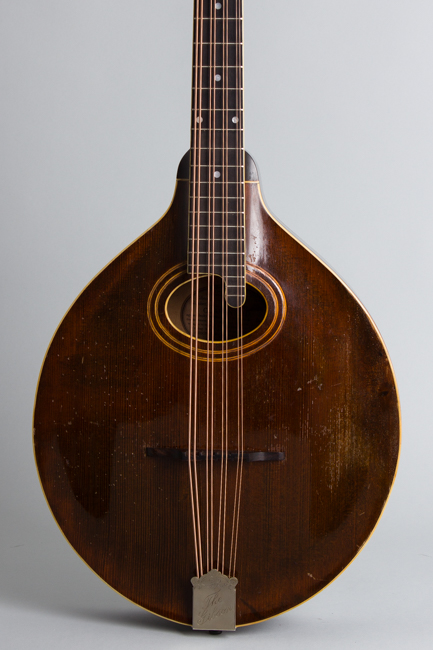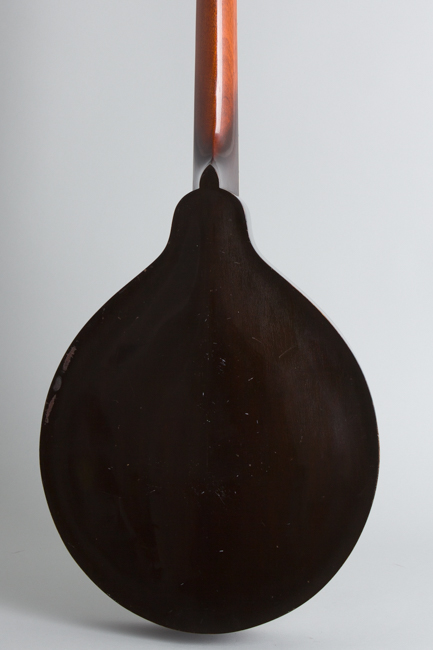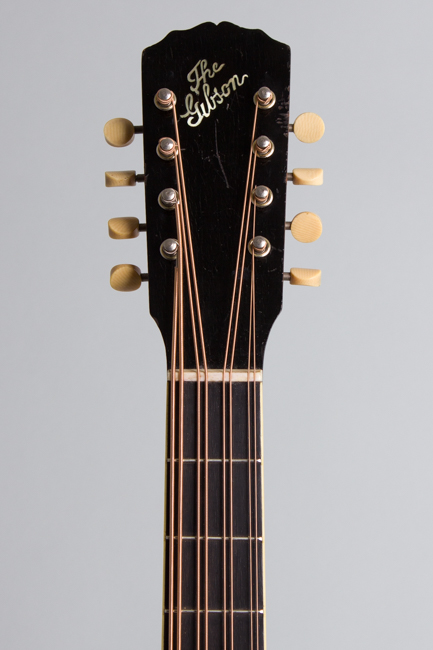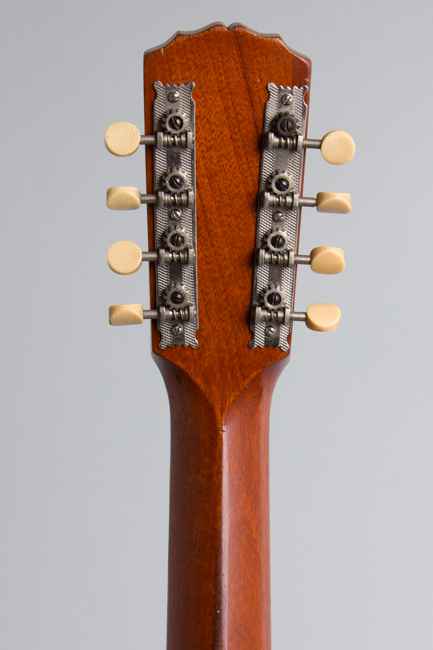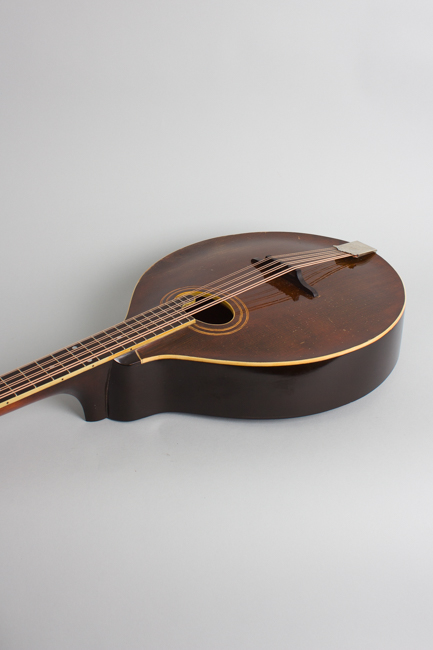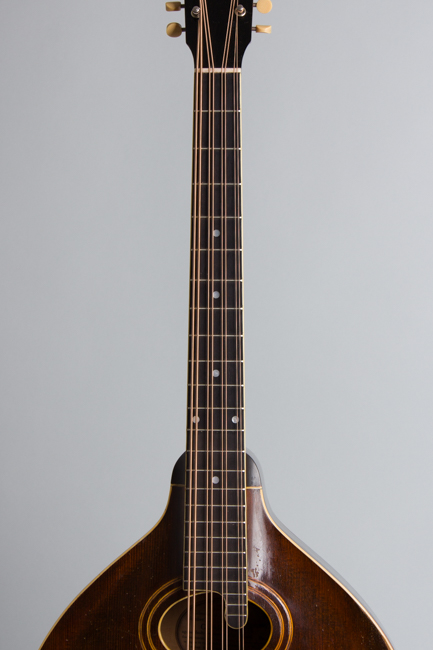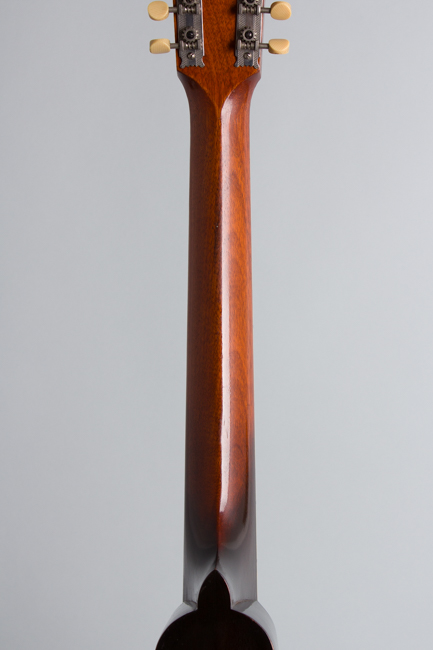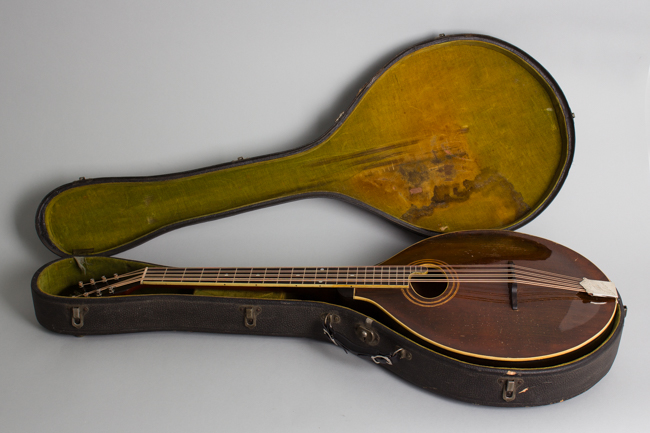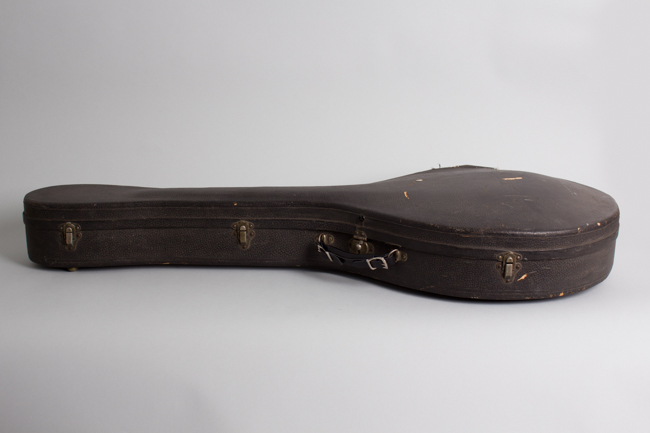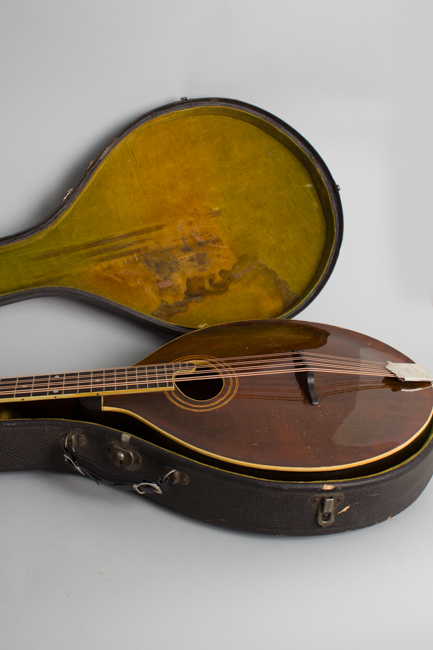Gibson K-1 Carved Top Mandocello (1921)
This item is currently on hold.
Item # 11947
Prices subject to change without notice.
Gibson K-1 Model Carved Top Mandocello (1921), made in Kalamazoo, Michigan, serial # 60912, Sheraton brown varnish finish, birch back and sides, spruce top; mahogany neck with ebony fingerboard, original black hard shell case.
We feel the Gibson Mandocello is one of the great under-appreciated instruments of the early 20th century. Originally designed for use in 1910s-era mandolin orchestras, these imposing beasts never found a home in any other style of music despite being unique-sounding creations. Double-strung and tuned in fifths starting with the C below the low E on the guitar, the mandocello has an imposing tone and deep resonance unlike any other fretted instrument. OK, we're starting to sound like an old Gibson catalog here, but we really like these and are always happy to get one in stock!
This particular instrument is a fairly worn-in but really fine sounding Style K-1 from the dawn of the 1920s. This was the most basic of the three mandocello models Gibson offered but still a fairly expensive instrument when new. It is structurally the same as the fancier Model K-2 with a little less "geegaw" (decoration). The headstock face carries just a plain pearl "The Gibson" inlay while the openback strip tuners are tipped with unadorned ivoroid buttons.
The top finish is what Gibson called "Sheraton Brown", a thin varnish shade particular to the late teens/early twenties period. The sound hole decoration is two separate wood inlaid rings and a bound edge. The K-2 had fancier versions of these decorative touches, but the physical features (and sound) were the same for both, with an oval body, bound carved spruce top with a flat oval soundhole and birch back. The necks on all models are mahogany, carved with a medium "V" profile topped with a bound and dot-inlaid ebony fingerboard.
This 1921 K-1 Mandocello dates to the decade when these mandolin family instruments were starting to fall from favor, and are less common than in the 1910s. Up through the mid-'20s Gibsons were only available from licensed teacher-agents, and were usually purchased on a time payment plan along with lessons. As part of the deal, the students would often play in the teacher's fretted orchestra, and the low-tuned mandocello was crucial to achieving a full sound in these ensembles. Far fewer were sold compared to mandolins, however, making Gibson mandocellos from any era a comparative rarity.
With its 8 strings and "C" orchestral tuning the mandocello has a totally unique sound and makes an excellent recording instrument. While mandolin orchestras are rather thin on the ground in the 21st century these instruments can be employed for a wide range of playing styles, some still yet to be explored!
Overall length is 38 7/16 in. (97.6 cm.), 14 1/8 in. (35.9 cm.) width, and 3 3/8 in. (8.6 cm.) in depth, measured at side of rim. Scale length is 24 5/8 in. (625 mm.). Width of nut is 1 5/8 in. (41 mm.).
This over-100 year old K-1 shows a decent amount of general wear; it is not cleanest we have had but sonically a fine example. The original top varnish shows some micro-checking and many tiny dings of unknown origin, along with more typical scrapes and chips, noticeable under the bridge feet. The lower edge has sone old overfinish over a spot of moisture wear that extends onto the rim as well. The back and sides appear to have been polished out long ago, with perhaps a thin coat of lacquer added; there is heavier scraping wear on the lower rim. The neck finish is the original fairly thin varnish with just some loss along the spine. There are dings, dents, scrapes and scratches overall and heavier checking on the headstock.
The back/side seams have been neatly re-glued in some spots, which it typical for these as the birch backs often have shrunken up over 100+ years. The instrument has no visible cracks or structural repairs. All hardware is original including the tuners, tailpiece and cover; the often missing pickguard and bracket clamp are gone, stains under the case lid indicating it likely disintegrated decades ago. The original one-piece carved bridge has been lowered a bit but is intact.
The one-piece mahogany neck is very solid; the original frets have been polished out and are in very playable shape, with a comfortable action. This is an excellent playing and sounding mandocello with a forceful tone. It includes the original HSC, which if missing today is almost impossible to replace. Overall Very Good + Condition.
We feel the Gibson Mandocello is one of the great under-appreciated instruments of the early 20th century. Originally designed for use in 1910s-era mandolin orchestras, these imposing beasts never found a home in any other style of music despite being unique-sounding creations. Double-strung and tuned in fifths starting with the C below the low E on the guitar, the mandocello has an imposing tone and deep resonance unlike any other fretted instrument. OK, we're starting to sound like an old Gibson catalog here, but we really like these and are always happy to get one in stock!
This particular instrument is a fairly worn-in but really fine sounding Style K-1 from the dawn of the 1920s. This was the most basic of the three mandocello models Gibson offered but still a fairly expensive instrument when new. It is structurally the same as the fancier Model K-2 with a little less "geegaw" (decoration). The headstock face carries just a plain pearl "The Gibson" inlay while the openback strip tuners are tipped with unadorned ivoroid buttons.
The top finish is what Gibson called "Sheraton Brown", a thin varnish shade particular to the late teens/early twenties period. The sound hole decoration is two separate wood inlaid rings and a bound edge. The K-2 had fancier versions of these decorative touches, but the physical features (and sound) were the same for both, with an oval body, bound carved spruce top with a flat oval soundhole and birch back. The necks on all models are mahogany, carved with a medium "V" profile topped with a bound and dot-inlaid ebony fingerboard.
This 1921 K-1 Mandocello dates to the decade when these mandolin family instruments were starting to fall from favor, and are less common than in the 1910s. Up through the mid-'20s Gibsons were only available from licensed teacher-agents, and were usually purchased on a time payment plan along with lessons. As part of the deal, the students would often play in the teacher's fretted orchestra, and the low-tuned mandocello was crucial to achieving a full sound in these ensembles. Far fewer were sold compared to mandolins, however, making Gibson mandocellos from any era a comparative rarity.
With its 8 strings and "C" orchestral tuning the mandocello has a totally unique sound and makes an excellent recording instrument. While mandolin orchestras are rather thin on the ground in the 21st century these instruments can be employed for a wide range of playing styles, some still yet to be explored!
Overall length is 38 7/16 in. (97.6 cm.), 14 1/8 in. (35.9 cm.) width, and 3 3/8 in. (8.6 cm.) in depth, measured at side of rim. Scale length is 24 5/8 in. (625 mm.). Width of nut is 1 5/8 in. (41 mm.).
This over-100 year old K-1 shows a decent amount of general wear; it is not cleanest we have had but sonically a fine example. The original top varnish shows some micro-checking and many tiny dings of unknown origin, along with more typical scrapes and chips, noticeable under the bridge feet. The lower edge has sone old overfinish over a spot of moisture wear that extends onto the rim as well. The back and sides appear to have been polished out long ago, with perhaps a thin coat of lacquer added; there is heavier scraping wear on the lower rim. The neck finish is the original fairly thin varnish with just some loss along the spine. There are dings, dents, scrapes and scratches overall and heavier checking on the headstock.
The back/side seams have been neatly re-glued in some spots, which it typical for these as the birch backs often have shrunken up over 100+ years. The instrument has no visible cracks or structural repairs. All hardware is original including the tuners, tailpiece and cover; the often missing pickguard and bracket clamp are gone, stains under the case lid indicating it likely disintegrated decades ago. The original one-piece carved bridge has been lowered a bit but is intact.
The one-piece mahogany neck is very solid; the original frets have been polished out and are in very playable shape, with a comfortable action. This is an excellent playing and sounding mandocello with a forceful tone. It includes the original HSC, which if missing today is almost impossible to replace. Overall Very Good + Condition.
